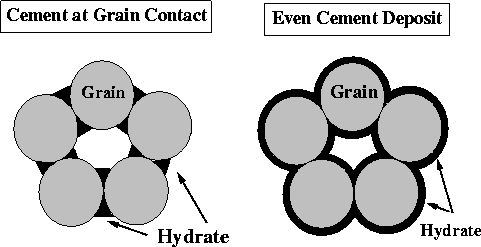Hydrate formation by cementation describes the mechanical interaction between grains that are bound together by intergranular cement, in this case hydrate Dvorkin and Nur (1993). This intergranular cement can be deposited either at the grain contacts or uniformly on the grain surface. A simplified scheme of these depositions can be seen in Figure 1. Since even soft cement is load-bearing Dvorkin et al. (1991, 1994), only small amounts of cement can significantly increase the stiffness and thus the elastic moduli of granular material and so reduce the porosity. The hydrate not only solidifies, but becomes part of the dry rock frame through its contacts with the grains. Using the theory described by Dvorkin et al. , we calculate the effective dry elastic moduli of the hydrate-cemented sandstone as
| |
(1) |
| |
(2) |
where Keff and Geff are the dry bulk and shear moduli; ![]() is
the density of pure hydrate, vph its P-wave velocity and vsh its
S-wave velocity.
is
the density of pure hydrate, vph its P-wave velocity and vsh its
S-wave velocity. ![]() is the initial porosity of the grains
before hydrate-saturation, and is the average number of grain contacts
for this specific porosity as given by Murphy 1982. The
parameters Sn and
is the initial porosity of the grains
before hydrate-saturation, and is the average number of grain contacts
for this specific porosity as given by Murphy 1982. The
parameters Sn and ![]() are proportional to the normal and
shear stiffnesses of a cemented two-grain combination and depend on the
amount of the hydrate (cement) and the hydrate and grain properties.
are proportional to the normal and
shear stiffnesses of a cemented two-grain combination and depend on the
amount of the hydrate (cement) and the hydrate and grain properties.
 |
The amount of hydrate ![]() depends on the way the hydrate is distributed
along the grains. In the case where it is deposited only at the grain
contact,
depends on the way the hydrate is distributed
along the grains. In the case where it is deposited only at the grain
contact,
| |
(3) |
while for a uniform hydrate deposition,
| |
(4) |
where S is the hydrate saturation of the pore space.